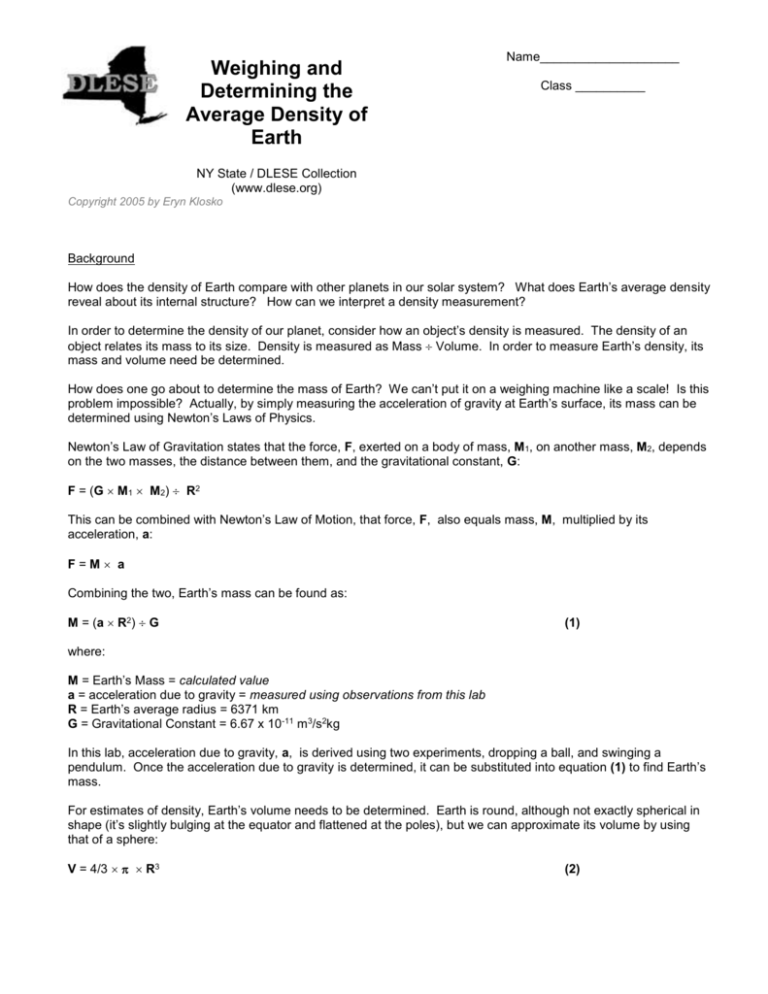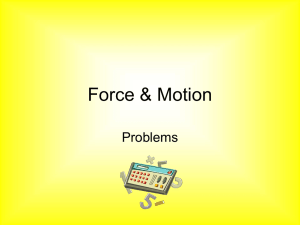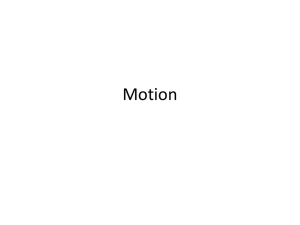Weighing and Determining the Average Density of Earth
advertisement

Weighing and
Determining the
Average Density of
Earth
Name____________________
Class __________
NY State / DLESE Collection
(www.dlese.org)
Copyright 2005 by Eryn Klosko
Background
How does the density of Earth compare with other planets in our solar system? What does Earth’s average density
reveal about its internal structure? How can we interpret a density measurement?
In order to determine the density of our planet, consider how an object’s density is measured. The density of an
object relates its mass to its size. Density is measured as Mass Volume. In order to measure Earth’s density, its
mass and volume need be determined.
How does one go about to determine the mass of Earth? We can’t put it on a weighing machine like a scale! Is this
problem impossible? Actually, by simply measuring the acceleration of gravity at Earth’s surface, its mass can be
determined using Newton’s Laws of Physics.
Newton’s Law of Gravitation states that the force, F, exerted on a body of mass, M1, on another mass, M2, depends
on the two masses, the distance between them, and the gravitational constant, G:
F = (G M1 M2) R2
This can be combined with Newton’s Law of Motion, that force, F, also equals mass, M, multiplied by its
acceleration, a:
F=M a
Combining the two, Earth’s mass can be found as:
M = (a R2) G
(1)
where:
M = Earth’s Mass = calculated value
a = acceleration due to gravity = measured using observations from this lab
R = Earth’s average radius = 6371 km
G = Gravitational Constant = 6.67 x 10-11 m3/s2kg
In this lab, acceleration due to gravity, a, is derived using two experiments, dropping a ball, and swinging a
pendulum. Once the acceleration due to gravity is determined, it can be substituted into equation (1) to find Earth’s
mass.
For estimates of density, Earth’s volume needs to be determined. Earth is round, although not exactly spherical in
shape (it’s slightly bulging at the equator and flattened at the poles), but we can approximate its volume by using
that of a sphere:
V = 4/3 R3
(2)
where:
V = Earth’s volume = calculated value
R = Earth’s average radius = 6371 km
= 3.1415…
Once the volume is measured, and the value of Earth’s average density, , determined as :
=MV
(3)
Using the average density of Earth, characteristics of Earth’s interior can be made (see lab part two).
Objectives – upon completion, students will review concepts of:
1. Law of Gravitation, applied to the Earth system
2. density
3. experimental errors
Relevance – solar system discussion (planet’s density), plate tectonics (density of oceanic crust vs. continental
crust), Earth’s interior structure
Materials
Ball drop apparatus:
steel ball
plastic ball
ball holder
cup
two photogates connected with timer
calculator
Pendulum apparatus:
stand
string
meter stick
weight
stop watch
Procedure
Photogate Experiment
A ball is dropped between two infrared sensors (gates) A and B connected to a timer. This system yields:
1) the time the ball takes to pass through gate A, tA
2) the time the ball takes to pass through gate B, tB
3) the total time the ball takes to go from gate A to gate B, tAB
The ball's velocity at each gate is the diameter of the ball, D divided by the time it takes to pass
through the gate. Thus, the velocity of the ball at each gate is:
vA = D t A
v B = D t B.
Because acceleration is the time derivative of velocity, a = v t, the ball's acceleration due to gravity can be found
as:
a = (vB - vA) tAB = {(D tB) – (D tA)} tAB = (1 tAB) [ {D (tA – tB)} (tA tB)]
1. Measure and record tA, tB, and tAB using the steel ball. Repeat for 3 trials. Record your results in the table
below. Find and record the average for these measurements.
2. Measure diameter of ball, and record it above table (see attached).
3. Repeat step 1 using the plastic ball.
4. Calculate the value of a using the values from the average times for the steel ball.
Pendulum Experiment
The period, T, is the amount of time taken for the swinging motion of a pendulum to repeat. Galileo first noticed that
the period of oscillation of any pendulum was dependent only on the length of the string used to suspend the mass,
and not on the mass.
Using observations of the period of the swing of a pendulum, the Earth’s acceleration due to gravity can be found
from the following equation:
a = ( 4 2 L ) T2
where:
L = length of string
T = period of motion = measured during experiment
1. Set the pendulum to a length of 0.5 meters.
2. Time how long the pendulum takes to make 10 oscillations. Record the
time in the table; repeat the trial five times.
3. Find the value of the period for each trial, average the values for time and period.
4. Calculate the acceleration due to gravity, a, for the averaged value of the period.
Questions
1. During the ball drop experiment, why is it useful to measure the acceleration due to gravity using more than one
method?
2. In the ball drop experiment, using two balls with different weights, which would fall faster?
3. In the ball drop experiment, how would positioning the time gates further apart affect the estimate of the
acceleration due to gravity?
4. In the ball drop experiment, how do the times for the two balls compare? Can you give any reasons for
similarities or differences that you observed?
5. In the pendulum experiment, what would happen to the period measurement if it was only taking for one swing
instead of the average of 10 swings?
6. In the pendulum experiment, how do you think your results and errors would change if you changed the length of
the string?
7. For both experiments, how well do your measurements of the acceleration due to gravity agree with the
accepted value of 9.8 m/s2? What might be some causes for a difference?
8. Calculate the Volume of Earth using equation (2). Remember to use units!
9. Estimate the volume of your classroom (recall, volume of a rectangle is Length x width x height). estimate how
many times bigger Earth is than your classroom. Think of it in terms of how many times you can fit your classroom
inside Earth. Remember to use the same units for the volume of your class room and the volume of Earth.
10. Calculate the Mass of Earth using equation (1). Remember to use units!
11. Estimate you own mass in terms of kilograms. How many more times greater is Earth’s mass than your mass?
12. Calculate the average density of Earth using equation (3). Remember to use units!
13. Crustal rocks on Earth have an average density of 3.0 g/cm 3. How does this compare with the average density
of Earth that you calculated? What does this imply about Earth’s density structure?
Data Table for Ball Drop Experiment
Diameter of ball, D = __________________ cm
Trial
1
Steel Ball
2
3
Average
1
Plastic Ball
2
3
Average
tA
(sec)
tB
(sec)
tAB
(sec)
M = 1 tAB
N = tA-tB
P=D N
Q = t A tB
a=PQ M
(cm/s2)
Data Table for Pendulum Experiment
Trial
L (m)
1
0.5 m
2
0.5 m
3
0.5 m
4
0.5 m
5
0.5 m
average
t = Time for 10
swings (sec)
T = t 10
(sec)
N = T2
(sec2)
Q = 4 2 L (m)
a=Q N
(cm/s2)








